(拓展模块 Unit9) 第四课时
- 格式:ppt
- 大小:450.00 KB
- 文档页数:15
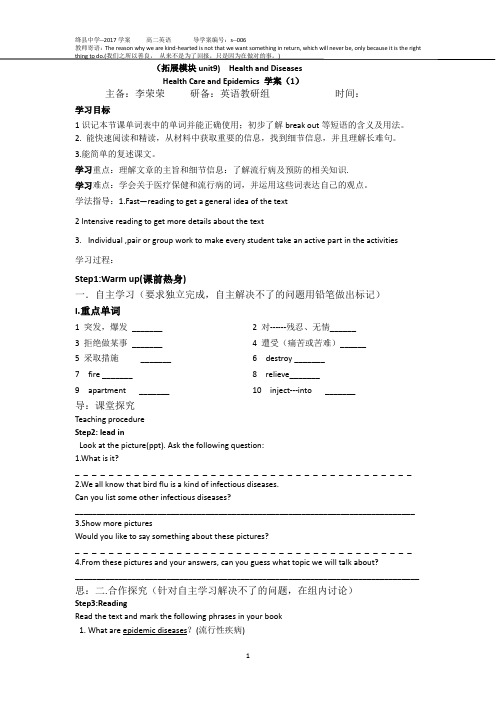
(拓展模块unit9) Health and DiseasesHealth Care and Epidemics 学案(1)主备:李荣荣研备:英语教研组时间:学习目标1识记本节课单词表中的单词并能正确使用;初步了解break out等短语的含义及用法。
2. 能快速阅读和精读,从材料中获取重要的信息,找到细节信息,并且理解长难句。
3.能简单的复述课文。
学习重点:理解文章的主旨和细节信息:了解流行病及预防的相关知识.学习难点:学会关于医疗保健和流行病的词,并运用这些词表达自己的观点。
学法指导:1.Fast—reading to get a general idea of the text2 Intensive reading to get more details about the text3.Individual ,pair or group work to make every student take an active part in the activities学习过程:Step1:Warm up(课前热身)一.自主学习(要求独立完成,自主解决不了的问题用铅笔做出标记)I.重点单词1 突发,爆发_______2 对------残忍、无情______3 拒绝做某事_______4 遭受(痛苦或苦难)______5 采取措施_______6 destroy _______7 fire _______8 relieve_______9 apartment _______10 inject---into _______导:课堂探究Teaching procedureStep2: lead inLook at the picture(ppt). Ask the following question:1.What is it?________________________________________ 2.We all know that bird flu is a kind of infectious diseases.Can you list some other infectious diseases?______________________________________________________________________________ 3.Show more picturesWould you like to say something about these pictures?________________________________________ 4.From these pictures and your answers, can you guess what topic we will talk about?_______________________________________________________________________________ 思:二.合作探究(针对自主学习解决不了的问题,在组内讨论)Step3:ReadingRead the text and mark the following phrases in your book1.What are epidemic diseases?(流行性疾病)2.Did you suffer from the epidemics? (遭受)3.Did the doctors inject a liquid vaccine into your arm to prevent some diseases? (注射、阻止)4. What kinds of epidemics do you know? (流行病的种类)5. fever 发烧flu 感冒headache 头疼Words reading2.Key words: suffer, occur, destroy, prosperous, fear, refuse, cure, relieve, liquid, inject Phrases: health care 医疗保健,suffer from 遭受(痛苦或困难), break out 突发,爆发Step 4. Fastreading1. Try to find topic sentences in each paragraphPara1:__________________________________________________________________________ Para 2: _________________________________________________________________________ Para 3: ______________________________________________________________________ Para 4: ______________________________________________________________________ Para 5: _______________________________________________________________________ Para 6: _______________________________________________________________________ Para 7: ______________________________________________________________________2.read the text fast. and get the main idea of each paragraph,then match the paragraphs with the sentences on paperPara 1__________________________________________________________________________ Para 2__________________________________________________________________________ Para 3__________________________________________________________________________ Para 4__________________________________________________________________________ Para 5__________________________________________________________________________ Para 6_________________________________________________________________________ Para 7__________________________________________________________________________ 议:Step5.Careful reading1.Read the passage carefully and slowly to get more detailed information, then complete the following answers to the questions .(1) What are epidemic disease?(流行性疾病)_______________________________________________________________________________ (2)What was the Black Death? (黑死病)____________________________________________________________________________ (3)How did people treat victims of epidemics in Europe during a plague a few hundred years ago?(如何对待流行病的受害者?)_______________________________________________________________________________ (4)How serious is flu to people?(流感对人的影响有多严重?)_______________________________________________________________________________ (5)What methods are used to prevent the outbreak of epidemics? (阻止流行性疾病的方法)_______________________________________________________________________________ (6)What can the government to do to protect its people from diseases? (政府举措)_______________________________________________________________________________ 展(show time):三.展示讲解(针对合作研讨解决不了的问题,由已会的同学或老师讲解)Step nguage points(Key words and phrases)1.Everyone __________________ disease at one time or another.每个人都会不时地遭受疾病的痛苦。
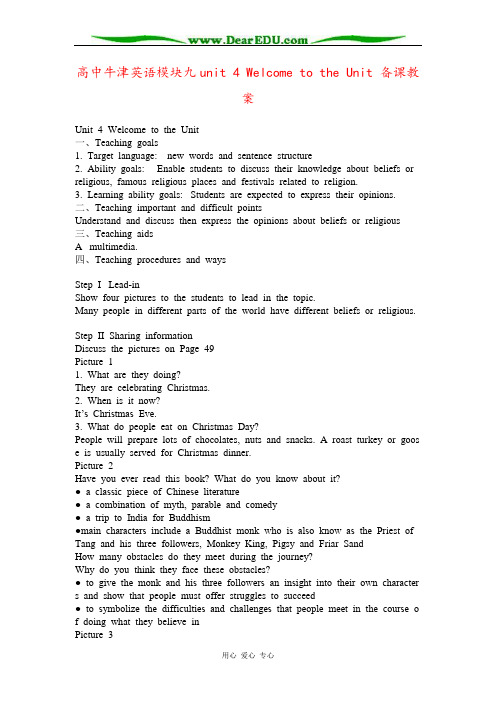
高中牛津英语模块九unit 4 Welcome to the Unit 备课教案Unit 4 Welcome to the Unit一、Teaching goals1. Target language: new words and sentence structure2. Ability goals: Enable students to discuss their knowledge about beliefs or religious, famous religious places and festivals related to religion.3. Learning ability goals: Students are expected to express their opinions.二、Teaching important and difficult pointsUnderstand and discuss then express the opinions about beliefs or religious三、Teaching aidsA multimedia.四、Teaching procedures and waysStep I Lead-inShow four pictures to the students to lead in the topic.Many people in different parts of the world have different beliefs or religious. Step II Sharing informationDiscuss the pictures on Page 49Picture 11. What are they doing?They are celebrating Christmas.2. When is it now?It’s Christmas Eve.3. What do people eat on Christmas Day?People will prepare lots of chocolates, nuts and snacks. A roast turkey or goos e is usually served for Christmas dinner.Picture 2Have you ever read this book? What do you know about it?● a classic piece of Chinese literature● a combination of myth, parable and comedy● a trip to India for Buddhism●main characters include a Buddhist monk who is also know as the Pr iest of Tang and his three followers, Monkey King, Pigsy and Friar SandHow many obstacles do they meet during the journey?Why do you think they face these obstacles?● to give the monk and his three followers an insight into their own character s and show that people must offer struggles to succeed● to symbolize the difficulties and challenges that people meet in the course of doing what they believe inPicture 31. What is a mosque used for?A mosque is a place for Muslims to worship2. Do you know any famous mosques in China?● the Id Kah Mosque in Kashgar, Xinjing. This mosque was built in 1442 and is the largest in China.● the Great Mosque in Xi’an, Shaanxi Province. It was built in the 18th centu ry with a traditional Chinese architectural style.Picture 4● Taoism is one of the major religions in China. It was founded by Lao-tzu i n about the 6th century BC. The most important text of Taoism is Tao-te-Ching. In the 5th century AD, Taoism develop as a religious system.● Taoism believes in ‘wuwei’, whi ch means that everything must follow its co urse and happen naturally.● The yinyang of Taoism has greatly influenced Chinese philosophy.Step III Discuss:1. Although there are so many beliefs or religions, do you think they have so mething in common?● Encourage people to do good● Have a power to call on people to devote themselves to that religion● Help people live their lives in a positive way● Motivate people to be compassionate, kind and loving2. Can you name any other religious around the world that you have heard of? Hinduism印度教Judaism犹太教Buddhism 佛教Islam伊斯兰教3. Do you know any famous religious places?The Mogao Grottoes (Dunhuang, Gansu )The White Horse Temple (Luoyang, Henan)The Vatican (Italy)Anuradhapura (Sri Lanka)Mecca (Saudi Arabia)Mount Wudang (Hubei Province)4. Do you know any festivals that are associated with these different religions? Show some pictures to the students to enjoy then discuss.For Buddhists (Nirvana Day, Buddha’s Day, Bodhi Day)For Christians (Good Friday, Easter Day, All Saints Day, Christmas Day) Muslims (Eid, The festival of sacrifice, Forgiveness Day)Homework:1. Search and discuss more knowledge about beliefs.2. Preview the reading part.。
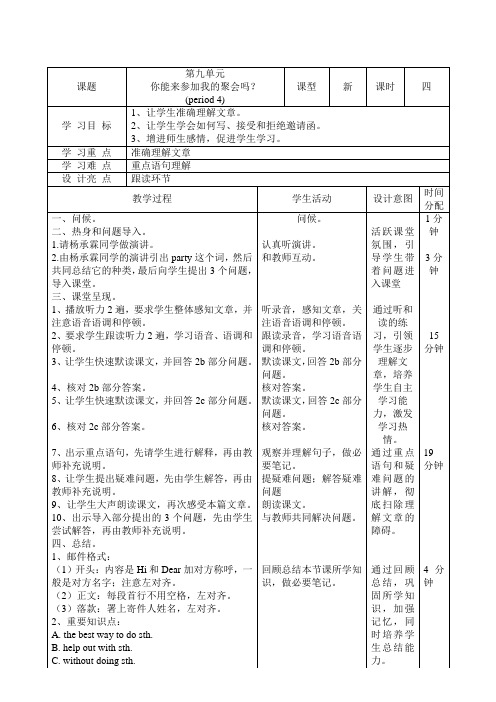
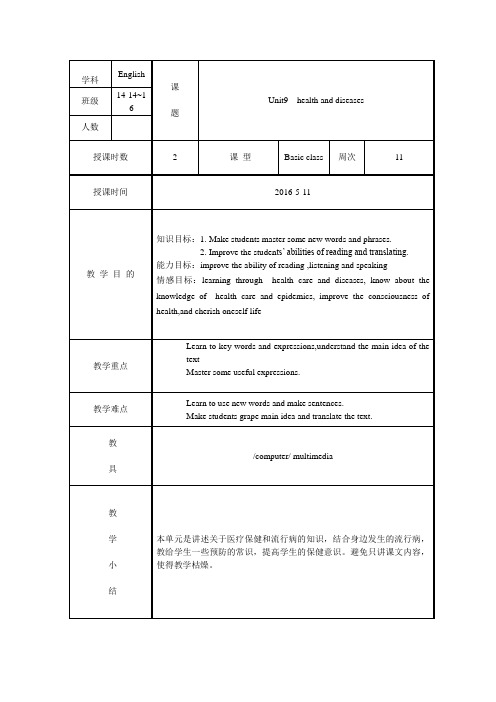

高中牛津英语模块九unit 4 Reading备课教案.doc(译林牛津版高三英语选修九教案教学设计)Unit 4 Reading Biblical idioms in English一、Teaching goals1. Target language: new words and sentence structure2. Ability goals: Enable students to gain some knowledge about idioms, understand their original meanings and learn about their practical usage in English.3. Learning ability goals: Students are expected to practice and reinforce their reading comprehension and improve their overall ability.二、Teaching important and difficult pointsGain some knowledge about idioms, and improve their overall ability三、Teaching aidsA tape recorder and a computer.四、Teaching procedures and waysStep I Lead-in1. Show pictures to students, and introduce something about the Bible.The Bible is often described as "the greatest book ever written." This is because of its unending significance and influence on people throughout the ages. No other book in history has impacted peoples and cultures like the Bible.Many basic concepts and principles of Western culture have come down from the Bible. Many common English phrases and expressions have their origin in the Bible well.Even though it was written more than 2,000 years ago, the Bible continues to influence people today.2. Enjoy a story in it.The Obstacle In Our PathIn ancient times, a king had a boulder placed on a roadway. Then he hid himself and watched to see if anyone would remove the huge rock. Some of the king's wealthiest merchants and courtiers came by and simply walked around it.Many loudly blamed the king for not keeping the roads clear, but none did anything about getting the big stone out of the way. Then a peasant came along carrying a load of vegetables. On approaching the boulder, the peasant laid down his burden and tried to move the stone to the side of the road. After much pushing and straining, he finally succeeded.As the peasant picked up his load of vegetables, he noticed a purse lying in the road where the boulder had been. The purse contained many gold coins and a note from the king indicating that the gold was for the person who removed the boulder from the roadway. The peasant learned what many others never understand. Every obstacle presents an opportunity to improve one's condition.Step II Fast readingscan the Internet article on page 50 quickly and find the answers to the Knowledge questions(细节复述型问题)which elicit factual answers and recognition of information, words, phrases or sentences in the passage as answers.1). What is an idiom?---An idiom is a group of words or an expression whose meaning often cannot be understood by looking at the meanings of the separate words in it.2). Which languages was the Bible first written in?---In Hebrew.3). Which idiom is often used to describe children?---Apple of their parents’ eyeStep III Careful reading1. Listen to the recording and follow, then read it carefully and answer the following questions in Part C1. These questions interpret some information in the passage, so finish them and try to improve the students’ ability to find specific information.1). Why does the Bible have a lot of idioms?---Because the Bible was first written in Hebrew and then translated into Greek, and many idioms are used in both of them. Because the Bible was translated into English hundreds of years ago, many Hebrew or Greek idioms have become part of the English language.2). What did ‘by and by’ originally mean in the Bible?---Immediately.3). What does ‘by and by’ mean today?---Before long.4). How many years ago was the Bible translated into English?---Hundreds of years ago.5). What does ‘feet of clay’ mean?---There is a hidden weakness in somebody whom we admire or respect.6). Which animals are featured in the idioms in the articles?---Bird and clay.7). Which foods are included in the idioms in the article?---Apple and salt.8). How is studying idioms useful in language learning?---You can improve your comprehension and develop a high level of competence in level of competence in communication skills.2. Complete Part C2, and it serves as a strengthening activity.Step IV Reading strategy: understanding analogies● When trying to understand idiom, it is often helpful to consider the use of analogy, which is a particular type of comparison.● Although analogy can be very hard to guess, clues can often be found in the context.● You should first look at the idiom and create an image in your mind.● Then look at the context to find out the context to find out the analogy and the message.Step V Usage of reading strategy1. I took my mother’s car without asking for permission. She is angry at me. I am in hot water now!2. Don’t tell anyone else that I am looking for a new job. Please keep it under your hat.3. We were not expecting to see Joan. When she suddenly arrived out of the blue, we were all surprised.Answers: 1. (in trouble) 2. (not tell anybody the secret)3. (suddenly; unexpected)Step VI consolidation3. Finish Part D. Guess the meanings of new words from the context.Answers: 1.j 2.b 3.a 4.c 5.e 6.d 7.f 8. h 9. g 10.I4 Finish Part E to review and consolidate knowledge in the text.Answers: (1) group (2) idioms (3) translated (4) Green (5) before long(6) underline (7) concept (8) weakness (9) bird (10) hiddenStep VII Discussion● What do you think about English idioms that come from the Bible?● Do you know the orig ins of any Chinese idioms? What are they?● Do you think understanding idioms is an important part of language learning? Why or why not?Step VIII Language points:1. (Lines 1-2) An idiom is a group of words or an expression whose meaning often cannot be understood by looking at the meanings of the separate words in it.1) Separate here is used as an adjective with the meaning ‘each or individual (word in the group of words or the expression)’ or ‘ not together’.e.g.●The twins share one room, but they sleep in separate beds.● Germany is one nation, but it used to be two separate countries for more than 30 years after World War Ⅱ.2) Separate can also be used as a verb, which means ‘to become apart’or ‘to be not together’.e.g.● It is extremely hard to separate two fighting oxen.● The mountain range separates the two countries.Have a try:●As we joined the big crowd I got _____ from my friends.A. separatedB. sparedC. lostD. missed●Students should always remember theory and should not at all be _____ from practice.A. dividedB. stoppedC. separatedD. operated2. (Lines 5-6) …, and unless you recognize when an idiom isbeing used, you can easily misunderstand what you read or hear spoken.◆ The word unless is a conjunction, which means ‘ if not’ or ‘except if’ and is used to introduce an adverbial clause of condition.e.g.● Unless I’m mistaken, she was at work yesterday.● You won’t get paid for time off unless you have a doctor’s note.● _______ invited, you should keep silent.A. WhenB. IfC. UnlessD. Since3. (Lines 33-35) For instance, children are often referred to as the ‘apple of their parents’ eye’, meaning that their parents love them very much and are very proud of them.1) The preposition as is something used with the phrase refer to, which means ‘to call somebody as’.e.g. He is referred to as the naughtiest student in his class.2) Refer to◆ ‘Refer to sb/sth’ means to mention or speak about sb/sthe.g.I promised not to refer to the matter again.◆ ‘Refer to sb/sth’ means to describe or be connected to sb/sth.e.g.This paragraph refers to the events of last year.◆‘Refer to sb/sth’ means to look at sth or ask a person for information.You may refer to your note if you want.◆ Have a try:The incident ____ took place last Monday.A. referredB. referringC. referred toD. referring toHomework:1. Read the article again.2. Note the important knowledge in the text.3.Do Part A1 and A 2 on page 124 in Workbook so they will have more chances to use some useful words and phrases leant in this section.。
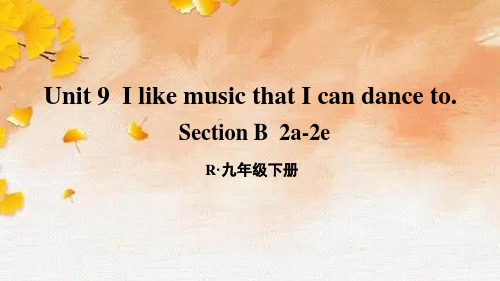
Unit9 When was it invented?Period4 (SectionB3a-4b)♦【教学内容】《Go for it!》教材九年级,Unit9 Period4 (SectionB3a-4b)♦【设计思路】由“My beverage"引出新单词——呈现3a图片猜测课文内容引出部分词汇——阅读文章并回答问题给出文章的支架模仿磁带跟读“Shen Nong^ s(ory”复述故事仿写“From pie plate to disk”----------------------- "Who is the best invento^?^^进行拓展。
♦【教学目标】一、语言技能目标1.能阅读含有被动语态的简短文章。
2.能简单介绍发明物的历史。
3.能根据给定的框架进行短文仿写,简单介绍发明物的历史。
二、语言知识目标1.能够灵活运用被动语态的肯定句与疑问句形式。
2.能用被动语态来描述发明物的历史。
三、情感态度目标1.了解茶叶的发明历史,增强民族自豪感和爱国主义精神。
2.了解飞盘的发明,了解西方文化,增强跨文化意识。
3.通过自己的小发明,培养学生想象力和创新思维能力。
♦【教学重难点】一、教学重点1•读懂介绍发明物历史的文章。
2.运用被动语态的句子,根据范文进行仿写,简单介绍发明物的历史。
二、教学难点灵活运用被动语态的句子进行范文仿写,简单介绍发明物的历史。
♦【教学准备】多媒体课件;配套磁带;录音机♦【教学步骤】Step 1 warming up and presentationShow them a glass of beverage made by myself and ask them these questions .1.What is it?Present "beverage" "mixture".2.How does it taste ?3.How does it smell ?What,s in it ?Present u produce9\u pleasanf\4.Can you guess how I invented it ?Present "by accidenf\(设计意图:通过让学生品尝老师自己制作的饮料来进行猜测同时呈现新词汇,既有趣有直观,印象深刻。
Unit 9 Reading: Job HuntingTeaching Aims:1. Get Ss. to learn the important expressions of the reading.2. Let Ss. know something about Interview Experience.3. Develop Ss. reading ability and let them learn different reading skills.Teaching Important Point:Get Ss. to read the passage to know about Interview Experience.Teaching Difficult Point:Develop Ss. reading ability.Teaching Procedures:Step1. Greeting and Revision.Check the useful words and expressions of Unit 9.1. accountant 5.refuse9.recommend2.salary6. fluently10.traffic jam3.quit7.promote4.translator8.promotion(设计说明:通过考查本单元重点词汇,督促学生及时识记单词,扎实学生的基础知识。
)Step2.Warming up. (free talk)1. Do you have a dream? If you do, then what is it?2. what kind of person would you want to be?T: Well done! You have many good dreams. But society develops very quickly. It is not easy to find a good job. After graduation from University,you must interview to find a job. Today ,Let us learn the reading about author’s interview experience.(设计说明:从学生熟知的话开始,有助于学生展开话题,营造轻松愉悦的课堂氛围,自然过渡到本节课的阅读学习。
Unit 9 When was it invented?Period 4Knowledge Objects:Reading (3a)WritingpairworkAbility Objects:Train students’ reading and writing abilityLanguage goalsWords & expressionsinvent, scoop, adjustable, operate, mistake, thin, sprinkle, sweet, salty, crispy, sour, discover, annoying, special, ancient, legend, boil, fire, nearby, remain, notice, produce, pleasant, throw, thousand, century, taste, smell, create, divide, shootKey sentencesWho invented them?They were invented in 1863.Ability goalsEnable the students to understand and use the new words of this unit.Emotion & attitude goalsEnable the students to be aware of different inventions around them.Strategy goalsEnable the students to use what they know to explain new words.Teaching important pointsUnderstand and use the new words and phrases.Teaching procedures and ways3a Reading and answeringNow let’s read to find out who invented tea. While you read, circle all the linking words and underline all the useful expressions.Who invented tea?Do you know that tea, the most popular drink in the world(after water), was invented by accident? Although tea was n’t brought to the Western world until 1610, this beverage was discovered over three thousand years before that. According to an ancient Chinese legend, the emperor Shen Nongdiscovered tea when he was boiling drinking water over an open fire. Some leaves from a nearby bush fell into the water and remained there for some time. The emperor noticed that the leaves in the water produced a pleasant smell. Later he decided to taste the hot mixture. It was quite delicious. And in this way, one of the world’s favorite drinks was invented.After you read, answer the 4 questions following the article.1. What is the article about?It is about the invention of tea.was it invented?It was invented over three thousand years before 1610.was it invented by?It was invented by Shen Nong.4. How was it invented?The emperor Shen Nong noticed that the leaves from a nearby bush in the water produced a pleasant smell. He tasted the hot mixture. It was quite delicious.Blackboard DesignUnit 9 When was it invented3b Writing an articleOn page 72 you will find notes in the box on the left. Write an article using the notes about the invention of the flying disk.From pie plate to flying diskA baker named William Russel Frisbie, of Warren, Connecticut, and later of Bridgeport, came up with a clever marketing idea back in the 1870s. He put the family name in relief on the bottom of th e light tin pans in which his company’s homemade pies were sold. The pans were reusable, but every time a housewife started to bake a pie in one, she would see the name Frisbie and, it was hoped, think, "How much easier to buy one". Eventually Mr. Frisbi e’s pies were sold throughout much of Connecticut, including New Haven.There, sometime in the 1940s, Yale students began sailing the pie tins through the air and catching them. A decade later, out in California, a flying-saucer enthusiast named Walter Frederick Morrison designed a saucer-like disk for playing catch. It was produced by a company named Wham-O. On a promotional tour of college campuses, the president of Wham-O encountered the pie-plate-tossing craze at Yale. And so the flying saucer from California was renamed after the pie plate from Connecticut. Of course the name was changed from Frisbie to Frisbee to avoid any legal problems.4a Thinking and inventionWe all have things that we don’t liking doing. Why not think of an invention that could help you. Write the details of your invention in the chart on page 72.ProblemLearning EnglishNew inventionA machine that translates English into ChineseUseThe machine “sees” the written English, and shows the translation.The machine “hears” t he spoken English, and repeats it in Chinese.Price100 yuan each4b Doing pairworkIn pairs ask each other questions about inventions, and try to sell your invention to your partner.You may begin as is shown in the box on page 72.A:This special pen was invented by Zheng Jie. It has three colorsand it is used for learning English.B: How is it special?A: When the red color is turned on, the pen reads out English as it ismoved along the line.B: When about the black color?A:When the black color is turned on, the pen finds out the structure of the sentences as it is moved along the line.B: When about the yellow color?A: When the yellow color is turned on, the pen shows the formation and meaning of the word as it is moved along the line.B: Wonderful! Where can I get one?A: I am the shop owner selling this kind of pen.…Closing down by talking about inventionInvention: abacus in c3000 BCInvention: abacusFunction: A counting device: a mechanical device for making calculations consisting of a frame mounted with rods along which beads or balls are movedNationality: ChineseInvention: Coca-Cola in 1886Definition: noun / trademarkFunction: Popular carbonated soft drink colored usually with caramel and flavored usually with extracts from kola nuts and sweetenersTrademark: U.S. issued 1893Inventor: John Stith PembertonCriteria; First to invent. Entrepreneur.Birth: July 8, 1831 in Rome, GeorgiaDeath: August 16, 1888 in Columbus, GeorgiaNationality: AmericanBlackboard designUnit 9 When was it invented?3b:The flying disk was invented by college students in the 1950s. they used a metal pie plate from a bakery in Bridgeport, Connecticut. Students are the bakery’s pies them threw the pie plates. Today, there are flying dish clubs, magazines and a festival.Umbrella: about 4,000 years ago in Assyria, China and EgyptBinoculars: 1854 Ignatio Porro in ItalyCamera: 1827 by Joseph Nicephore Niepce who took the first pictureBicycle: 1880s in EnglishExercise改正下列句子1. This house built 100 years ago. ________________________________2. Football plays in most countries of the world. ____________________3. Why did the letter send to the wrong address? ____________________4. A garage is a place where cars repair. ____________________5. Where are you born? ____________________6. How many languages are speaking in Switzerland? ____________________7. Somebody broke into our house but nothing stolen. ____________________8. When was invented the bicycle? ____________________。